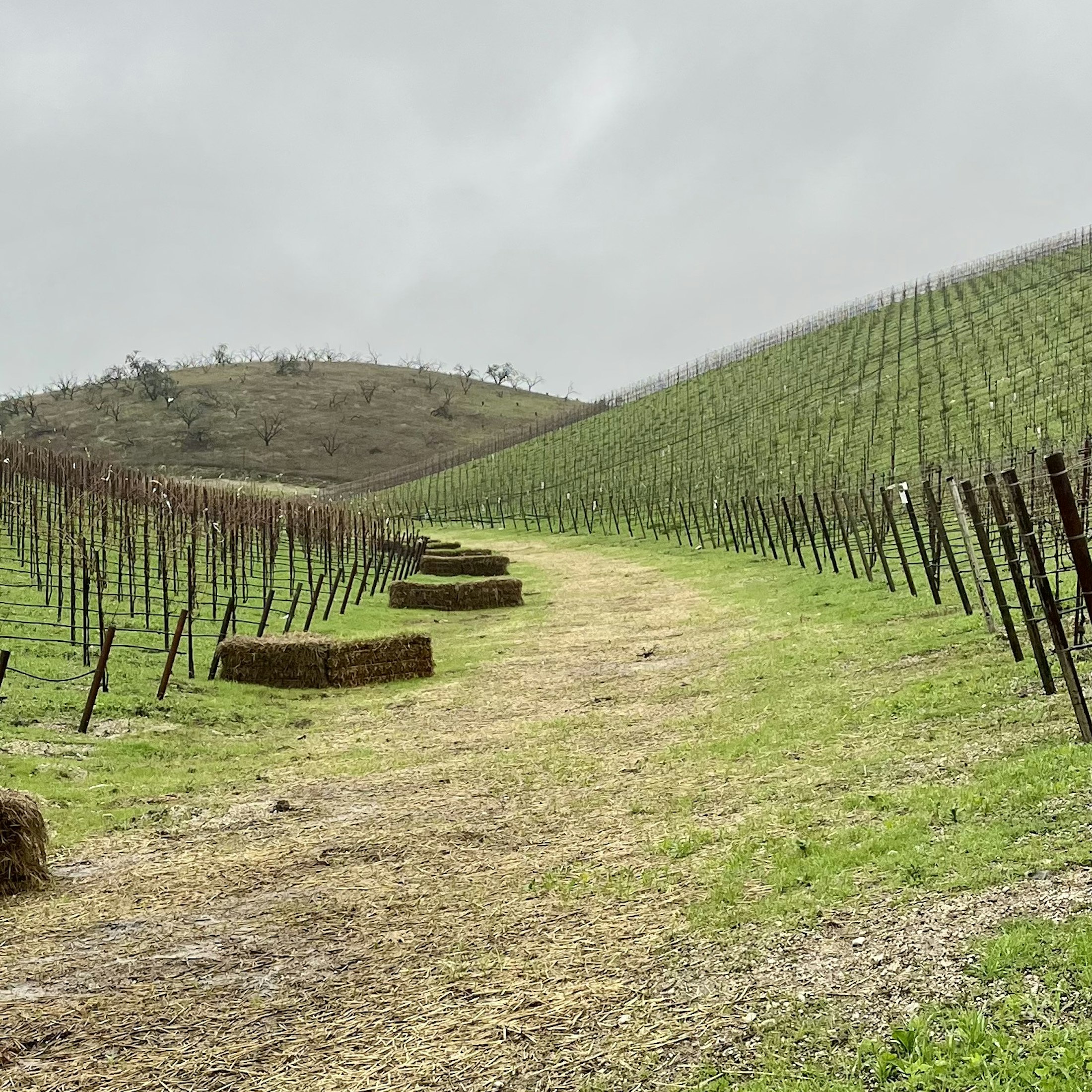Wet And Wild: How Winter Rains Shape The 2023 Vintage


Rain, Erosion and Soil Health
The heavy rains of winter brought a multitude of benefits and drawbacks to the vineyards this year in Paso Robles. While the storms replenished depleted underground aquifers, the rain arrived with such force most farmers were scrambling to stay ahead of erosion control, compost additions, and tractor work before things got too soggy.
It was a race to spread organic compost materials and cover crop through the Thibido Vineyard ahead of the rains in order to allow mother nature to do her work. When rainwater penetrates the ground, it helps to blend compost and organic matter into the soil. The force of the rain pushing down on the compost facilitates its incorporation, enriching the soil with vital nutrients. Rain can also flush unwanted salts in the soil, improving soil pH and overall health.
It’s no secret that the steep hills of our Thibido estate vineyard have presented erosion challenges in the past(Upper Left Image). The year we began prepping for the vineyard was the winter of 2018 and we spent three months shoveling mud and apologizing to our downhill neighbors for the muddy runoff. Planting the vineyard became synonymous with a progressive erosion control approach. In 2019 we installed a large pit drain at the lowest corner of the vineyard (Lower Left Image), a series of waddles along valleys and vinerows, and I spread bales and bales of hay every year ahead of the winter rain to disperse the rainfall and deter heavy ruts and damaging erosion.
Winter rains contribute to the success of our cover crops grown between vine rows. Mother nature’s irrigation assisted in a robust cover crop of vetch, legumes and other vegetation used to prevent soil erosion and add organic matter when mowed and folded into the soil of the vineyard.

It’s A Jungle Out There
Abundant rain equates to big canopies and thriving happy vines who don’t know their limits. While growth is beneficial for maximizing the plants’ photosynthesis and sugar production, too much of a canopy and too much fruit production on a vine will stress the plant and lower the quality of the fruit leading to large volumes of flavorless, watery wine. Spring sunshine and rapid vine growth equate to the ultimate farming race; shoot-thinning each vine by hand to encourage a healthy canopy, ensure optimum sunlight exposure and air circulation, deter mildew or disease, and promote the vine’s overall well-being.
Shoot-thinning isn’t the only preventative maintenance necessary to ensure high quality fruit this harvest, we’re monitoring cluster count per vine, too. When plants are well-watered and well-fed, we can expect more clusters per vine and the clusters themselves may weigh more. If the goal is to grow the most flavorful, balanced grape to produce the most flavorful, balanced wine, then we must limit each vine’s cluster count to ensure the resulting fruit is concentrated and quality. Thinning the clusters and dropping excess fruit is a difficult part of farming. This process is done manually, hand selecting the clusters to clip and leaving the remaining clusters on the vine that are in good position for light and growth. Seeing all those grape clusters fall to the ground to shrivel and decompose can feel like we’re wasting product, but our focus is on quality, not quantity. Protecting the vine from over producing ensures each cluster will be attentively nurtured by the vine as it swells and ripens for harvest.


Predictions for 2023 Vintage?
This winter was a game changer in the Paso Robles AVA, resetting our water dials and refreshing our vineyards. So far, this year Mother Nature has teed up the perfect growing season for outstanding wines in the 2023 vintage. For attentive farmers focused on quality over quantity, this harvest should produce beautifully balanced, flavorful fruit resulting in fantastic wines. For farmers overhanging fruit in hopes of producing a bumper crop, the resulting wines will be thin and one-dimensional. Meticulous farming practices, exercising control with growth management and using what nature provides will guarantee unprecedented structure and concentrated fruit flavors for 2023 vintage wines. I’m really looking forward to the harvest from the Thibido estate vineyard this fall and how the fruit will determine the wines we produce!